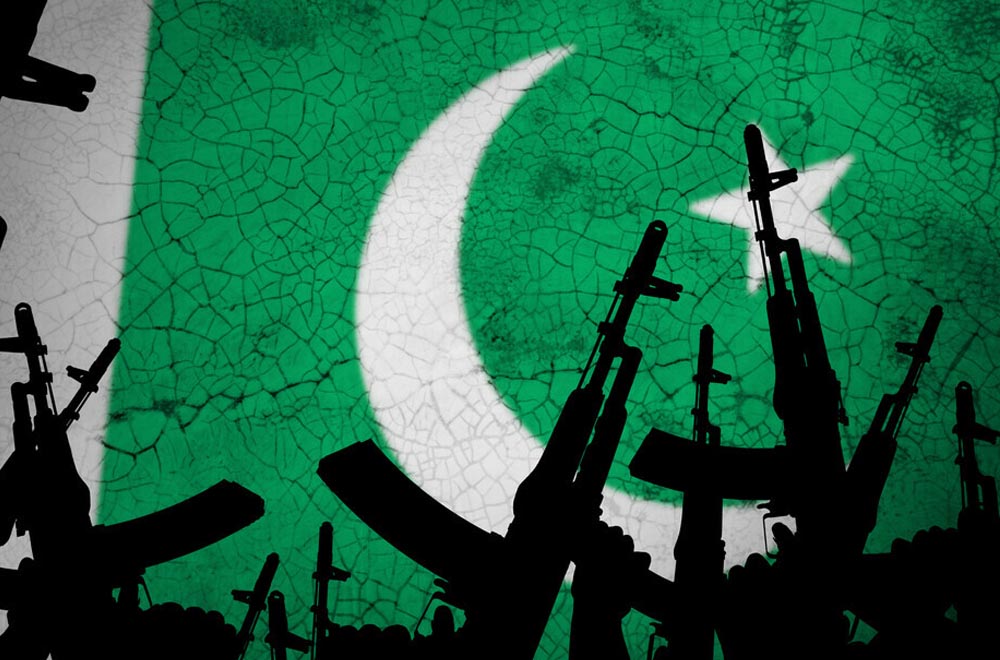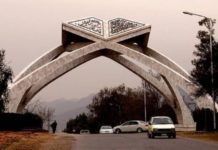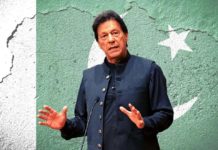As troubled Pakistan enters 2024 let’s first hear the good news: no longer do armed militant groups gather on every street corner or ride double-cabin pickups with weapons in hand. It wasn’t always so. In fact, 25-30 years ago, there were so many groups that remembering all their names wasn’t easy. Jihad-i-Kashmir and Jihad-i-Afghanistan banners, posters, and songs were everywhere. Today, although the official website of the Pakistan Army still displays the Ziaul Haq era motto ‘Imaan, Taqwa, Jihad’, army recruiting centres no longer exhibit oversized banners bearing ‘Jihad Fi-Sabeelillah’ (jihad for Allah).
The path towards the present has been long and there’s much shyness about discussing the past. Absence of public discussion means that few people understand what changed, how, and when. While many welcome downplaying jihad, others feel this was imposed on Pakistan by external actors and some dream of reversing it.
No single event turned the tide but the APS massacre of 2014, executed by TTP as part of its putative jihad, was significant. Every day, more reason is being added by its murderous assaults on Pakistan’s security forces. This year 23 soldiers lost their lives in a single gruesome suicide attack by those seeking Taliban-style rule in Pakistan. Still bigger attacks had happened earlier (Peshawar mosque, 2021). Pakistan routinely blames India but the problem is Kabul.
Pakistan has reached out to Afghanistan’s new leaders repeatedly, hoping to build a protective ideological fence. Since TTP sees this as a religious war, Pakistan demands a fatwa declaring attacks on Pakistani forces as haram. But the Taliban government has balked at this. Visits by two foreign ministers, an ISI chief, and many high-level Deobandi clerics — Maulana Taqi Usmani included — achieved little. Whether Maulana Fazlur Rahman’s charm offensive will succeed remains to be seen.
It seems like only yesterday when Blackwater and India, aided and abetted by Hamid Karzai and then Ashraf Ghani, were decried as the founts of terrorism. And so, when the Taliban finally triumphed in 2021, Pakistan’s military and political class was euphoric. The Afghan jihad had succeeded — India had been booted out and American plans for an orderly withdrawal had been thwarted.
Experiments with cross-border jihad are thankfully over but nationalists are still being tyrannised.
Who can forget the celebrations after the fall of Kabul and then prime minister Imran Khan’s ecstatic “breaking the chains of slavery”? The Urdu press and TV channels were thrilled. ‘Our boys’ — many trained in Pakistani madressahs — had won. The cherished goal of strategic depth had finally been reached.
But within months, the euphoria turned into sulking gloominess. Those who brought disaster to our doorstep will not talk about it. Therefore, it is all the more important to keep reminding ourselves of just how and why it all happened.
That story must start in 1987 with the failed cross-LOC experiment. Delhi’s unconscionable manipulation of Kashmiri politics caused a popular uprising against Indian occupation. Kashmiris fled Indian repression by the thousands and crossed into Pakistan’s side of the LOC. Thereupon Pakistan’s planners hit upon the bleed-India-with-a-thousand-cuts strategy accompanied by flat denials of involvement.
This seemed an ideal low-cost option for eventual victory, a means to change an otherwise unchangeable stalemate. India’s wrongdoing became an excuse for creating a militarised Pakistani security state that, for selfish institutional reasons, sought to keep Kashmir boiling forever. Fortuitously, the Soviet-Afghan war had just ended leaving behind a surplus of battle-hardened fighters hungry for new challenges.
Militants such as Hafiz Saeed’s LeT and Masood Azhar’s JeM were seen as well-suited for the task. Others, such as Sipah-i-Sahabaand Lashkar-i-Omar, were sectarian and aimed against Baloch nationalists. Yet others — the most important being TTP — were unintended by-products.
By 2002, there were already enough jihadist groups in Pakistan to warrant a guidebook. Through their public rallies and donation boxes in markets and shops, they made their presence and identities fully known. Pakistan had become a magnet for fighters everywhere from Europe to the Middle East and Central Asia to Indonesia.
The period between 2002 and 2014 was marked by increasing ambiguity, duplicity and cross-killings. With multiple centres of power, the empire of holy war became an unholy mess. Who was killing who and for what end? Politicians and senior army commanders cut their own private deals with jihadist groups. In 2010, then chief minister Shehbaz Sharif, through his contacts in Al-Qaida, proposed that normal relations be established with TTP as quid pro quo for sparing Punjab from terrorist attacks.
By one estimate, between 2001 and 2013 about 49,000 Pakistani citizens, police, and soldiers had been killed. The fervour for jihad began to fade. Fear of being blacklisted by FATF and diplomatic isolation led to Hafiz Saeed, a jihad icon and LeT’s founder, being steadily downgraded. He was eventually sentenced to two prison terms each of five and a half years. Like uncounted others, he was no more than a cheap, disposable tool.
The Kashmir experiment eventually sputtered to a halt. On Oct 5, 2019, then prime minister Imran Khan tweeted that “anyone crossing the LoC from AJK to provide humanitarian aid or support for Kashmiri struggle will play into the hands of the Indian narrative”. What good the cross-border experiment did — other than leave thousands dead on all sides and isolate Pakistan diplomatically — must be asked of those who imagined and organised the Kashmir jihad. Wresting Kashmir from Indian rule has become doubly difficult today.
Fortunately, Pakistan has moved up the learning curve. Fruitless negotiations with TTP have rightly been abandoned and terrorists are being confronted with force. But Pakistan’s Punjab-centric leaders have learned nothing about how to handle outstanding national grievances. A recent example is the extrajudicial murder of Balach Baloch, one which has led to mass protests across Pakistan.
The establishment’s present attitude towards nationalists must change. Just as it was sensible to abandon cross border jihad, it makes sense to abandon the failed hard-fist approach. To harass and arrest PTM leaders (who are strongly anti-Taliban), or to abduct peacefully protesting Baloch youth, defies all reason. Dealing with Pakistan’s estranged nationalists needs political sagacity and a willingness to accept them as equal citizens of Pakistan who have been wronged. Else, be prepared for unending militancy and a miserable 2024.









